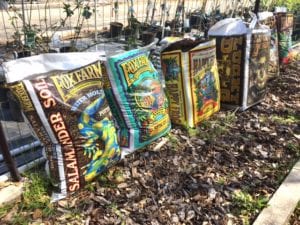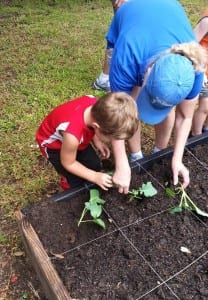I feel it. Do you feel it? Although there may be a smattering of cold days here and there, the sun is making itself known. I’ve already seen new growth pushing up from the ground on many of my perennials. The birds have an extra little peep in their chirps, and a few butterflies have already come sniffing around believing their nectar sources should be in bloom already. Spring wants to be here just as much as we want it to be here. If you have visions of gathering fresh tomatoes, peppers, and squash from your very own garden this spring and summer, you still have time to build a raised bed but you need to get on it doggone it! Today I’m going to give you a few ideas to consider when building your raised beds. With a little preparation you can expect a very successful growing season.
Site:
(The more sun the better when it comes to growing your vegetables.)
Picking the location of where you will place your raised bed should be on the top of your list. Your veggies need to grow in a spot where they will receive about 15 hours of direct sunlight each day. Too little sunlight tends to give you leggy plants that don’t produce adequate fruit. Also consider placing your beds in the North to South direction so that your taller plants won’t shade your shorter ones. You don’t want your spinach and parsley screaming, “Down in front!” at your tomato plants all season.
Area:
(You shouldn’t feel like your plants are out of reach in your veggie garden!)
When making plans for your raised bed, you want to consider the correct length and width. As for width, it’s a good rule of thumb to follow a “rule of arm”. This means, make sure your garden width is around double your arm length (4′ to 5′). You want to be able to easily reach and tend to all the goodies you have planted. Nothing is worse than seeing a prized zucchini ready to be plucked off the vine but having no easy way to reach it. In no circumstances should you have to walk across your garden soil to get to the veggies on the other side. Compacting your soil by trampling it can be the kiss of death to your plants. You should be able to access everything in your garden from all sides. As for the length of your garden bed, it really depends on how much you want to plant. 15′ to 20′ long is a pretty good size. If you have dreams of planting even more and think you can handle it, consider building two raised beds next to each other with a nice pathway in between.
Depth:
(Save your back and build up. It’s no fun bumping into limestone with each shovelful.)
One of the reasons so many of us gardeners choose to grow in raised beds is because of the native soil most of us are cursed with here in San Antonio. To describe it, the word “yuck”comes to mind. For one, our soil is for the most part alkaline and we have to constantly amend it to make it suitable to grow anything in it. For two, it is darn hard to dig through the limestone to a suitable depth to be able to plant vegetables. Veggies need a depth of at least 15″ to 18” to be able to fully develop roots strong enough to produce healthy, and strong plants. You can achieve this depth much easier by building up rather than digging down.
Soil:
(Soils from Fox Farm are a great way to fill up your raised garden bed.)
By building up, you’ll be able to choose whatever soil you’d like to grow your veggies in. Steer clear of topsoil in your raised beds. Topsoil is too heavy and will cause your soil to become compacted. You want a nice loose soil that allow your roots to spread and stretch their legs so they will be able to take in the most nutrients. You could choose to make a blend of 50% Fox Farm Soil Conditioner and 50% of one of their other soils like Happy Frog or CocoLoco. Or fill your bed up with an all-in-one product like Ladybug Square Foot Garden Blend.
Planting:
(Measuring feet with string is an easy way to mark your planting spots.)
Now that you’ve got your bed all set up with the correct location, the correct width, length, and depth, it’s time for the fun of planting your vegetables. Make time to plan a little before heading out to the nursery to make your purchase. It is easy to get swept up in the excitement when all the veggies are stocked and beckoning you to pick them. Decide what you want to plant before you go shopping. Make sure you have room for all that you want to plant and make sure you plan to actually make use of the plants you are choosing. You can use a square foot gardening method to figure out your spacing (there are tons of plans on the web), or stagger your plants in your garden giving yourself around 15″ to 18″ in between plants. You want to give your plants enough space for good air circulation to get around them, but plant them close enough to help prevent competing weeds from growing. *On a side note, if you happen to round your soil up in your garden (like a short dome), you can give yourself an extra foot of space to plant in. Small plants like spinach, greens and smaller herbs are perfect for planting along the sides.* Don’t forget that you can offer up more space by planting vertically in your gardens. Cucumbers sprawl and can take up a ton of space, but offer them a trellis and you’ve made room for 2 or 3 more veggies to be planted around them. Many veggies can be grown vertically given the correct support.
(Raised Garden from one of our customers, Crystal Combs.)
I hope you decide to give a raised garden a try this year. They soil in them tends to warm up faster allowing your seeds to germinate quicker, they drain better than in ground gardens, and they can be built within a day without the back-breaking labor of pulling large slabs of limestone out of the ground. Check around on the internet to find a raised garden plan that will suit your needs, come see us for the perfect bed mix to fill it up, then come to Rainbow Gardens with your plans for what you’d like to grow. Let us double check your ideas so we can help to make sure you have the most successful growing season yet. Let’s get started, spring is right around the corner.
The Happy Gardener
Lisa Mulroy









Do you know where I could find a place, locally in San Antonio or a reputable online seller, that sells ready made raised garden beds that can be put together? I don’t have carpentry skills or material to cut and nail lumber.
Hi Susan,
While I’m not sure about ready made, we can recommend Uprooted Gardens, a company that comes out and custom build raised garden beds. Click the link for their website. We’ve had them out to Rainbow Gardens multiple times for seminars and workshops on raised bed gardening.